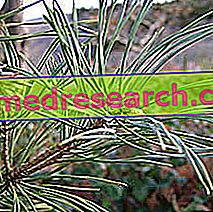
Scientific name
Arctostaphylos uva urs i, sin. Arbutus uva ursi
Family
Ericaceae
Origin
The plant is a shrub with small, spatula-shaped, evergreen and leathery leaves. It is native to the temperate regions of the northern hemisphere, northern Europe, Asia and North America. Traditionally the decoction of the bearberry leaves was used for the treatment of urinary infections.
Used Parts
Drug given by fresh or dried leaves (Official Pharmacopoeia)
Chemical constituents
- Hydroquinone glucosides (arbutoside or arbutin, methylbutine);
- Hydrolyzable tannins;
- Iridoid glycosides (monotropein);
- Flavonoids (myricetin);
- Terpenoids (alpha- and beta-amirine, uveolus, ursolic acid).
Bearberry in Herbalism: Properties of the bearberry
Bearberry is used as a diuretic and urinary disinfectant, as well as an astringent. The antibacterial effect is due to arbutin, whose metabolites in the urine release hydroquinone, which has demonstrated antibacterial activity.
The urinary antiseptic action of hydroquinone requires - to fully manifest - an alkaline pH of urine and a concentration of active ingredient of at least 60 μg / mL.
Biological activity
As mentioned, diuretic, disinfectant and astringent activities are attributed to bearberry. These properties have been confirmed by several studies and it is precisely for this reason that the use of the plant has obtained official approval for the treatment of urinary tract infections. More in detail, the disinfectant action is ascribed to the hydroquinone arbutin glycoside.
However, in order for Arbutin to perform its disinfectant action, the urine must have an alkaline pH; this is necessary for generating the hydroquinone of arbutin, which is directly responsible for the antiseptic action.
In fact, after oral administration of bearberry preparations - then, after oral arbutin intake - by the action of a beta-glucosidase, the latter is hydrolysed freeing its hydroquinone, which - after conjugation at the level hepatic - becomes water-soluble and is secreted via the kidney, where it returns free and active in the presence of a basic environment.
Hydroquinone has been shown to be effective in countering urinary infections sustained by different types of bacteria, such as: Staphylococcus aureus, Bacillus subtilis, Escherichia coli, Proteus vulgaris, Pseudomonas aeruginosa, Enterococcus faecalis, Mycobacterium smegmatis, Shigella somnei and Shigella flexneri .
Another study, however, showed that the ethanolic extract of bearberry leaves is able to generate cutaneous hypopigmentation. Based on the results obtained, this study hypothesizes that the aforementioned extract may be a potential and useful bleaching agent, to be used topically in the adjuvant treatment of skin disorders characterized by hyperpigmentation.
It is no coincidence that in the cosmetic field bearberry is already used in preparations used to counteract skin blemishes (for more detailed information on this, see the article on "Bearberry Extract in Cosmetics") ).
Bearberry against urinary infections
Thanks to the diuretic and disinfectant action exerted by the hydroquinone glycosides - in particular from the arbutin - contained within the plant, bearberry proved to be a valid and useful remedy for the prevention and treatment of urinary infections sustained by several bacterial strains.
For the treatment of these disorders, the plant must be taken internally.
Generally, it is recommended to take a quantity of vegetable drug corresponding to 400-800 mg of arbutin per day (calculated as an anhydrous arbutin), to be administered in 2-3 divided doses.
In any case, for more information about the uses of bearberry in the treatment of the aforementioned urinary disorders, it is advised to read the article dedicated to "Curing with bearberry".
Bearberry in folk medicine and homeopathy
The disinfectant properties exerted by the bearberry at the level of the urinary tract are also well known in folk medicine, which uses the plant precisely for the treatment of various diseases of the urinary tract, but not only. In fact, traditional medicine uses bearberry also for the treatment of various types of disorders at the genital level and at the level of the bile ducts.
Bearberry can also be used in homeopathic medicine, where it can be found in the form of mother tincture, granules and oral drops.
In this context the plant is used in case of infections of the urinary tract, cystitis and tenesmus.
The dose of homeopathic remedy to be taken can vary from individual to individual, also depending on the type of disorder that needs to be treated and according to the type of preparation and homeopathic dilution that you want to use.
Side effects
Following the consumption of bearberry irritations of the mucous membranes and hepatic parenchyma, gastric irritation, nausea and vomiting may occur, probably due to the high content of tannins (15-20%).
In the event of an overdose, however, inflammation and irritation of the mucous membranes of the urinary tract and bladder may occur.
Furthermore, after taking bearberry for long periods, hepatotoxicity can occur, particularly in children.
Contraindications
Avoid taking bearberry in case of proven hypersensitivity to one or more components, in patients with liver failure, kidney disease, digestive disorders and in patients with an acid urinary pH.
In addition, the use of bearberry is also contraindicated in pregnancy (particularly in the first trimester, as it can induce uterine contractions and facilitate placental detachment), during lactation and in children under 12 years of age.
Pharmacological Interactions
- enhancement of the anti-inflammatory effect of dexamethasone, prednisone, indomethacin (administered parenterally);
- the disinfectant effect of bearberry is reduced by foods or drugs that acidify urine.
Warnings
In order for the therapeutic activity to manifest itself, the urine should preferably be alkaline, as may occur spontaneously in some infections, otherwise it should be made alkaline by the administration of suitable urinary alkalinisers, such as citric acid, potassium citrate and the juice of citrus fruits. A diet rich in vegetables can promote the production of slightly basic urine.
My-personaltrainerTv Videos
Uva Ursina
Watch the video
X Watch the video on youtubeCranberry - American Cranberry
Watch the video
X Watch the video on youtube



